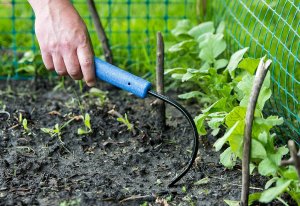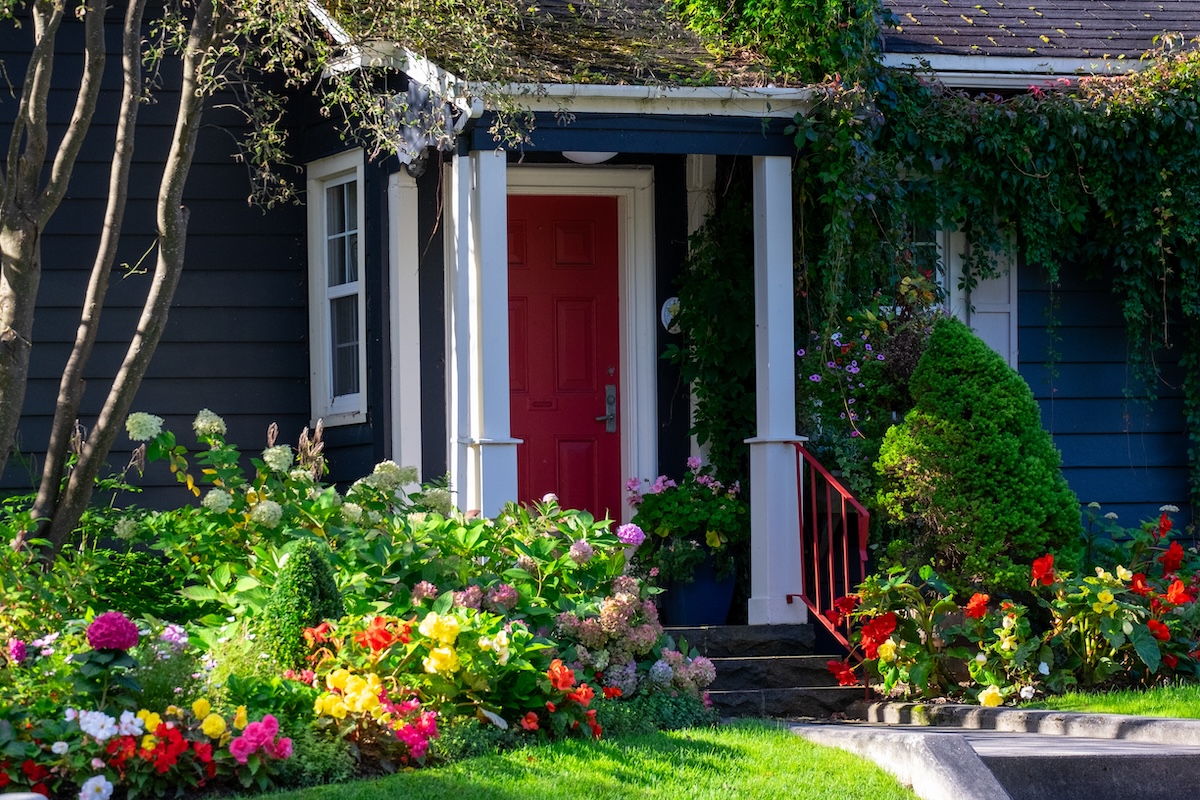

We may earn revenue from the products available on this page and participate in affiliate programs. Learn More ›
Shrubs can serve as foundation plants that enhance a home’s curb appeal and add to its personality. When carefully selected, front garden bushes can add privacy, block street noise, and frame a home with natural beauty, especially when the shrubs are layered with trees or annual flowers. Shrubs can reduce soil erosion in a sloped yard, and front yard shrubbery along the home’s foundation can help shield the home from wind in winter and add shade in the summer, particularly when planted on the south side.
Planting the right landscaping shrubs in front of your house can even increase your home’s property value. Studies have shown that attractive landscaping can increase a home’s sales price by 5.5 to 12.7 percent. To reap the greatest benefits, look for shrubs that suit your property’s growing conditions, meet your maintenance needs, offer year-round interest, and will mature to the optimal size for your landscaping. Read on for a list of the best shrubs for the front of the house, and pick up some pointers for selecting the best plants for your property.
How to Pick the Right Shrubs

Finding the best shrubs for the front yard requires planning and thoughtful assessment. Aesthetics matter—shrubs should add beauty to the landscaping and be in proportion to the size of the home and property. But practical considerations like maintenance requirements and water needs are also crucial.
Growing Zone and Home Orientation
Select a shrub suited to your area’s hardiness zone, but also consider heat tolerance, paying special attention to your home’s orientation. Garden beds along the north side of your home are the coolest, so for a northern exposure, you may want to opt for a shrub that thrives in a cooler USDA Plant Hardiness Zone to ensure it survives a harsh winter. Plants along western and southern walls will experience more temperature fluctuations from heated wall surfaces.
Water Needs
Before purchasing, consider a shrub’s water requirements and also how easily you’ll be able to water it in its intended location. Don’t plant a shrub in the path of a downspout, and don’t plant it too low. Having drip emitters or a faucet nearby will save time. Opt for drought-tolerant shrubs if you live in a dry climate.
Soil Conditions
Test soil pH, or estimate it based on your region’s typical soil makeup, before investing in a new shrub. Also, check to see how well the soil drains in the area where you intend to plant it. Note that soil around a foundation may drain poorly, be compacted from construction work, or exhibit higher soil pH from substances like leached limestone or calcium in building materials.
Sun Exposure and Intensity
Light duration and intensity can affect how much a plant blooms or how its foliage changes color in fall. While the site’s orientation will certainly affect sun exposure, also consider the amount of shade a shrub will receive from the house, other structures, or nearby trees.
Scale and Size
Shrubs grow to different heights and widths. When selecting a shrub, particularly if it will be planted along the home’s foundation, be sure to research its expected height and width at maturity. Otherwise, it may end up looking out of place, too small (or too large) for the scale of the house or nearby plantings, or it may block windows or other plants. After planting a shrub, it might look small for the first few years, but it will fill in as it grows. It’s also important to consider a shrub’s mature height when incorporating shrubs into a layered transition from trees to smaller plants.
Fit With Home and Landscape Style
Think about your home’s architectural style and whether you have (or want) a formal or informal landscape. For example, boxwood can match contemporary or formal landscapes (with some pruning), but it does not look good with native or natural landscapes. Consider flower size and color when selecting flowering shrubs for the front of your home to ensure they will suit the facade and nearby plantings.
Ability to Produce Seasonal or Year-Round Color
Flowering shrubs typically bloom only in spring through late summer, but some boast other attractions, such as evergreen foliage, colorful berries, or leaves that change color in fall. To ensure your front yard has four seasons of color, balance shrub choices with trees and other plants. If you have an evergreen ground cover and an ornamental grass that features seed plumes in fall and winter, you might not need an evergreen shrub. Depending on the size of your property and how many shrubs you need, look for a few spring bloomers, a few summer stunners, and some that offer fall color.
Expected Maintenance
Be realistic about your ability or willingness to maintain your shrubs. An unmotivated gardener who selects shrubs for the front of the house that require heavy pruning or other maintenance may end up with unsightly growth, disruptive spread, or disappointing flowering. Low-maintenance bushes and shrubs are the best bet for busy homeowners or gardening novices. If you’re patient, select native shrubs that grow slowly, since they will probably need less pruning. Expect most shrubs to need one trim or pruning per year, so check plant information for timing.
18 of the Best Shrubs to Plant in Your Front Yard
Once you have a landscape plan in mind and have taken the above considerations into account, it’s time to start shopping for shrubs for the front of your house. Before you purchase, check with local sources for tips on how your favorite shrubs fare in your area. For instance, some shrubs may be deemed invasive in one part of the country but cause no problems in another area. Certain shrubs might also be more susceptible to disease in one climate than another. Consider these factors as you evaluate the growing requirements and selling points of the following shrubs.
1. Potentilla (Dasiphora fruticosa or Potentilla fruticosa)
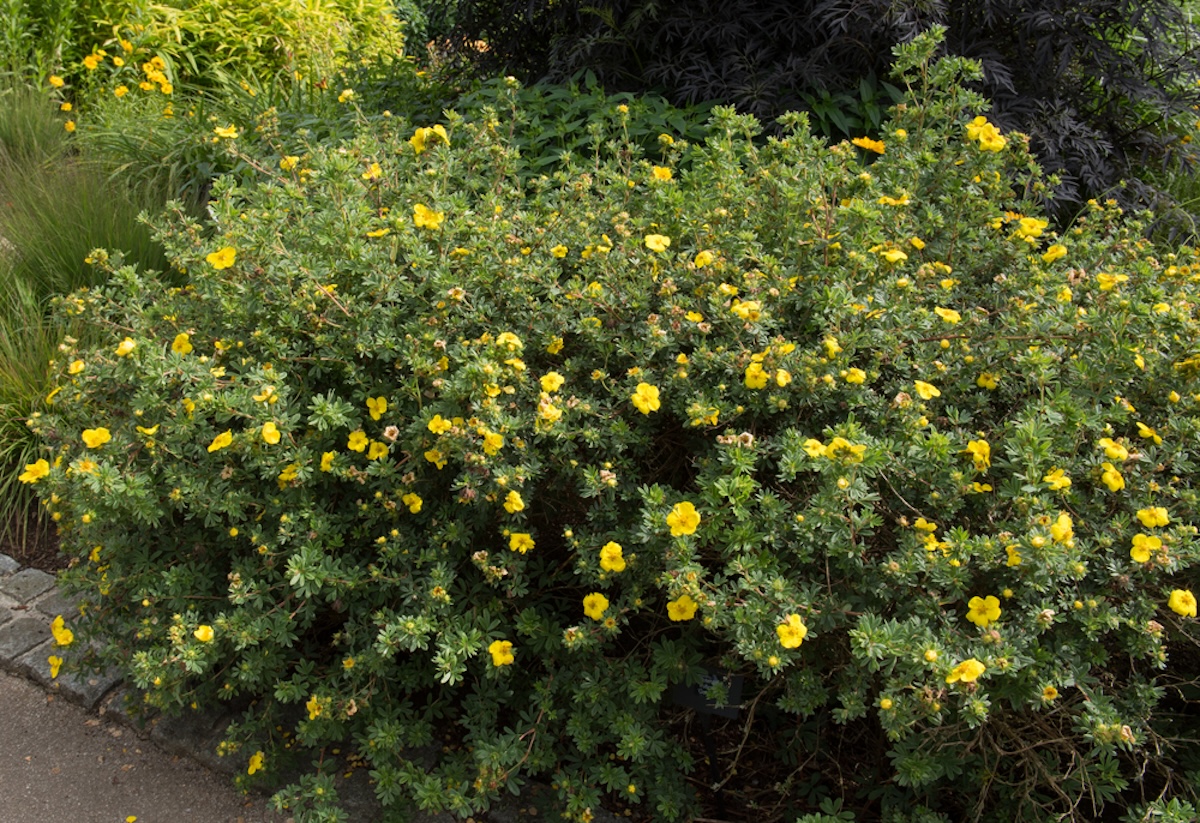
Also known as shrubby cinquefoil, this low-maintenance shrub was reclassified as Dasiphora in 2023, so look for plant care information and shrubs for sale under both names. A relative of roses, cinquefoil features 1-inch symmetrical flowers with five petals against delicate deep-green foliage. This North American native is even more striking in its hybrid forms, which can boast yellow, white, or coral flowers. Although it fares best in cool and mountain climates, potentilla remains one of the easiest shrubs to grow. It is considered a low-water plant and requires no pruning, or a light spring pruning into a rounded shape.
Best For: Natural or pruned look in cool climates and low maintenance
USDA Hardiness Zones: 5 to 7
Size: 1 to 6 feet high; 2 to 3 feet wide
Light: Full sun
2. Rhododendron (Rhododendron spp.)

Because rhododendron varieties are evergreen and have larger leaves, these perennial shrubs are sometimes used in privacy hedges. Like their azalea relatives, rhododendrons are low-maintenance woody shrubs that can offer some wind protection near the front of a house, especially the evergreen varieties. They produce bell-shaped flower clusters in white, pink, purple, red, or orange in mid to late spring. Although they are colorful stunners, rhododendrons can be susceptible to insects and diseases, along with deer damage; they also prefer acidic soil. So be sure to follow care instructions and consider an alternative shrub if deer frequent your front yard.
Best For: Specimen or screening plants, lots of flower color options
USDA Hardiness Zones: 4 to 8, depending on variety
Size: 6 to 10 feet high; 5 to 8 feet wide
Light: Partial shade, dappled light
3. Azalea (Rhododendron spp.)

Azaleas are rhododendrons that bloom earlier (April) and have tubular-shaped flowers. They feature dense, dark foliage crowned in the spring by vibrant, sometimes fragrant, blooms of white, purple, pink, red, yellow, or orange. Most prefer partial shade, but some azalea varieties are shrubs that can handle full sun. Azaleas prefer moist, acidic, but well-draining soil. If you need shorter shrubs, select a dwarf azalea. All can be pruned for shape, size, and structure. They typically add a natural, informal style to landscapes.
Best For: Added bursts of spring color
USDA Hardiness Zones: 4 to 8, depending on variety
Size: 3 to 15 feet high; 2 to 6 feet wide
Light: Partial shade, dappled light
4. Hydrangea (Hydrangea spp.)

For showy, long-lasting blooms in white, pink, blue, or purple (depending on your soil’s pH) from summer through fall, the hydrangea can’t be beat. Most are deciduous, with lush green foliage. Their natural form lends an informal look, but many varieties are amenable to pruning to shape. This easy- and fast-growing shrub prefers partial shade or an eastern exposure in your landscape.
Best For: Informal landscapes or cottage gardens
USDA Hardiness Zones: 3 to 9
Size: 2 to 15 feet high; 2 to 12 feet wide
Light: Partial shade to full sun
5. Rose (Rosa spp.)

Roses, beloved symbols of love and beauty, are some of the most popular shrubs for full sun. Many hybrids are available in colors ranging from white to pink, red, lavender, orange, and yellow, and the flowers can be single or double. Heirloom cultivars are often fragrant. Most rose bushes grow to a manageable height for placing in front of a house. Pruning roses can be tricky due to the technique and thorns, and some varieties are susceptible to disease. Knock Out roses are known to be particularly easy to grow.
Best For: Pairing with foliage plants in full sun
USDA Hardiness Zones: 3 to 9
Size: 3 to 6 feet high; 3 feet wide
Light: Full sun
6. Boxwood (Buxus spp.)

With its glossy leaves, the boxwood is one of the most popular low-maintenance evergreen shrubs, and it can be a good choice for small spaces. One option, Franklin’s Gem boxwood, reaches about 2 feet tall, making it ideal for placing in front of taller shrubs or along walkways for year-round greenery that won’t overtake the sidewalk. Winter Gem, a slow-growing type of boxwood shrub reaching 6 to 8 feet tall, is easy to control by pruning to shape. Gardeners with some pruning savvy can shape their boxwoods into topiaries or hedges.
Best For: A manicured, neat appearance in partial or full sun
USDA Hardiness Zones: 5 to 9
Size: 2 to 20 feet high; 2 to 8 feet wide
Light: Full sun to partial shade
7. Juniper (Juniperis spp.)

Evergreen shrubs that thrive in full sun, junipers can be short enough to act as ground cover or tall enough to be hedges or trees. Some varieties, such as Stricta and Blue Star, have an aquamarine or blue tint to their foliage. Most spread up to 4 feet, which is perfect for foundation planting, and most grow slowly. Look for varieties that grow to the height you desire. The shrubs can handle most soils, are drought-tolerant, and are considered low-maintenance evergreens. Some junipers are prone to disease or contribute to seasonal allergies, so check with local sources.
Best For: Low-effort winter color
USDA Hardiness Zones: 3 to 9
Size: 2 to 15 feet; 3 to 10 feet
Light: Full sun
8. Yew (Taxus spp.)

A soft-needled, slow-growing evergreen conifer, the yew is usually counted among low-maintenance bushes in landscaping for shady areas, although it can also handle sun. Its dense foliage and ability to grow to various sizes make it a popular privacy hedge choice in cool growing zones. However, dwarf varieties offer height options, and yews are easy to prune to size or shape, endearing them to gardeners who value formal landscapes. In late summer to fall, red berry-like fruit punctuates their finely textured green foliage. Be careful of placement: All parts of the yew plant are toxic to people, dogs, cats, and horses.
Best For: Any space that calls for an attractive evergreen
USDA Hardiness Zones: 4 to 8
Size: Up to 20 feet high; 3 to 20 feet wide
Light: Partial shade to full sun
9. Euonymus (Euonymus spp.)

Another of the shrubs for shade in the front of the house, euonymus varieties are low-maintenance, hardy shrubs that can grow to roof height. Of the more than 175 varieties, Burning Bush is probably the most familiar cultivar, thanks to its fiery red fall foliage that makes it among the best evergreen shrubs for the front of the house. It also features modest growth, eventually reaching about 6 feet high and wide. Other varieties grow taller, and all of these fast-growing shrubs can be left to grow naturally or manicured to shape or to form a hedge.
Best For: Beautiful fall foliage or forming a compact hedge
USDA Hardiness Zones: 6 to 9
Size: 4 to 15 feet high
Light: Partial shade to full sun
10. Lilac (Syringa spp.)
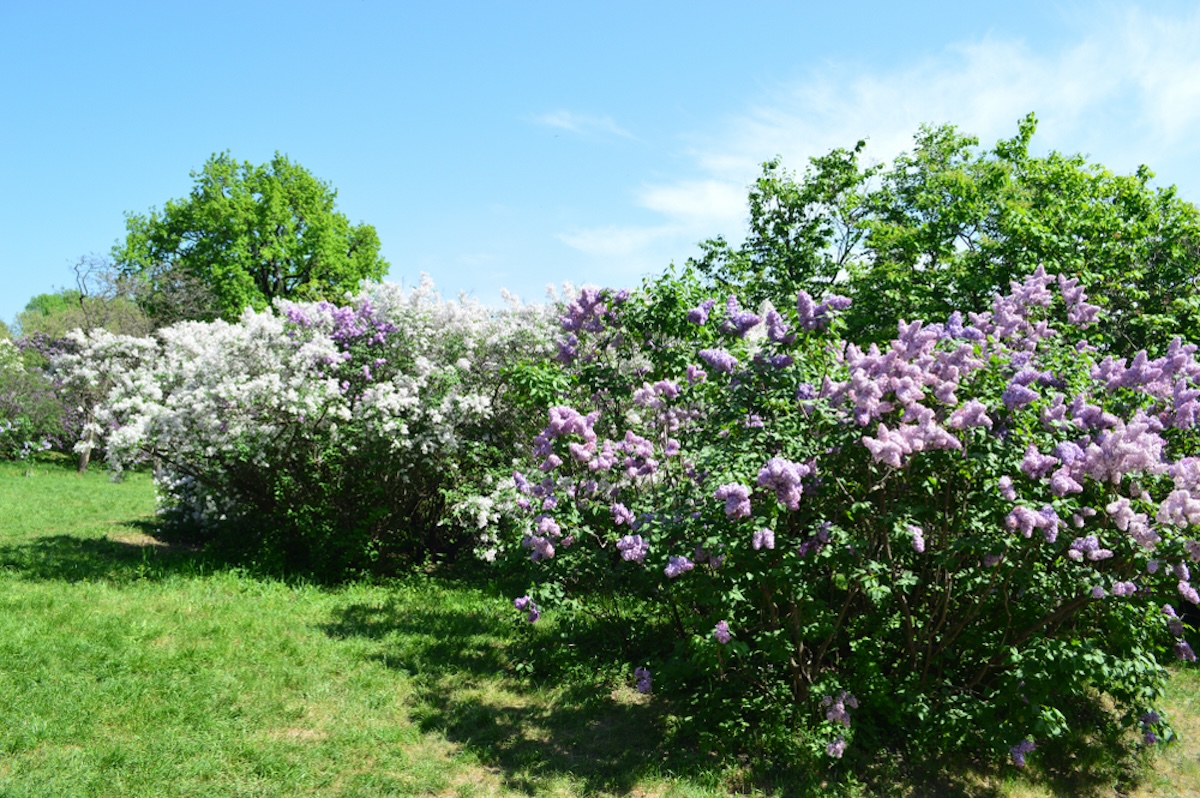
The go-to shrub for cool climates is also one of the most colorful shrubs for the front of the house, with fragrant blooms that emerge each spring. Although it loses some of its appeal after blooming, the shrub produces blooms on old wood, so you can prune it for shape and even into a hedge after the flowers fade. Lilacs attract pollinators but are deer- and rabbit-tolerant. Choose Syringa vulgaris ‘Yankee Doodle’ for deep purple flowers, or opt for the white flowers of S. vulgaris ‘Angel White.’ Beware: The Japanese tree lilac (S. reticulata) is invasive in some regions.
Best For: Fragrant spring blooms in spots with full sun
USDA Hardiness Zones: 3 to 7
Size: 12 to 16 feet high; 8 to 12 feet wide
Light: Full sun
11. Holly (Ilex spp.)

This holiday favorite is a low-maintenance evergreen shrub with dark-green, glossy notched leaves and bright red winter berries that attract birds. Most are low-growing shrubs, but American holly (Ilex opaca) can grow to a staggering height of 30 feet; it and other varieties can form a trimmable privacy hedge. Many holly varieties grow slowly and do well in a range of sun exposures. Mature hollies are drought-tolerant and can handle a variety of soil types. The fruits are slightly toxic.
Best For: Producing pretty berries in winter and small flowers in spring
USDA Hardiness Zones: 5 to 9
Size: 2 to 12 feet high; 2 to 10 feet wide
Light: Partial shade to full sun
12. Weigela (Weigela florida)
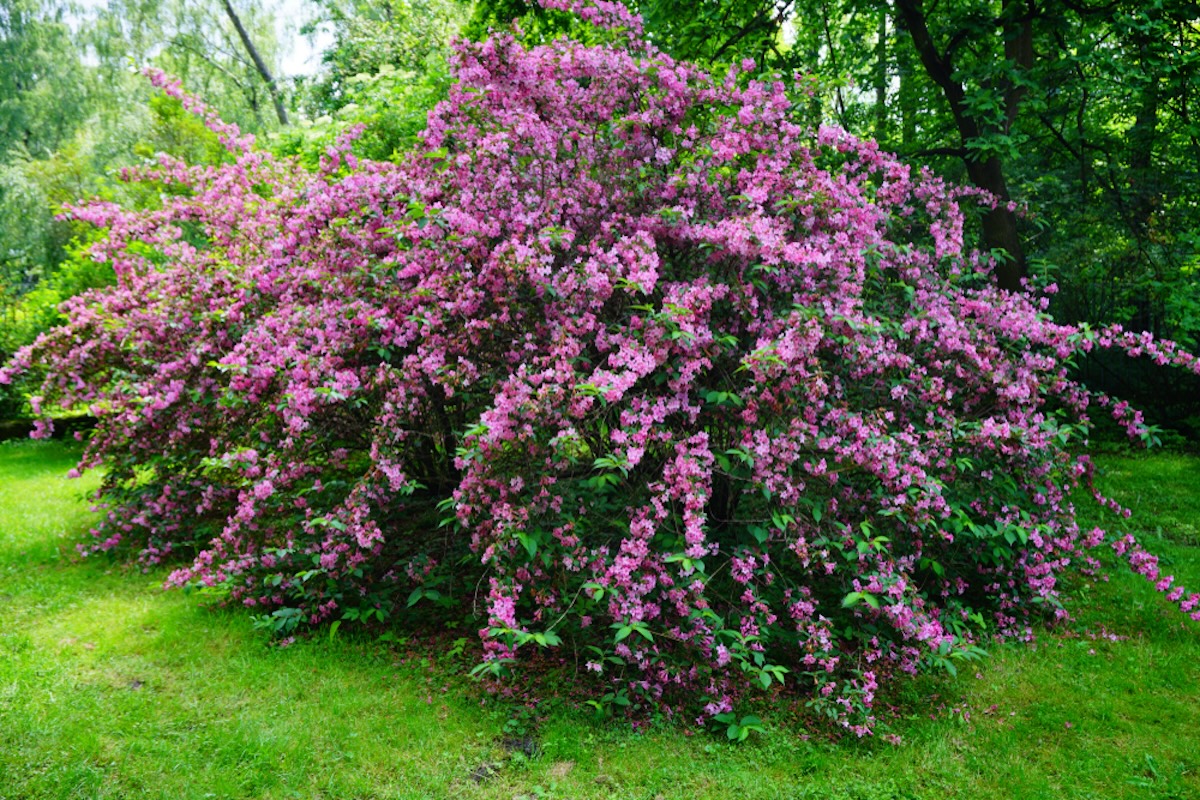
Among spring’s most colorful shrubs, weigelas feature yellow, white, pink, or red funnel-shaped blooms. Some types have variegated or purple leaves, adding to the colorful display. The sun-loving weigela comes in a wide range of sizes and is one of the good shrubs for the front of the house, working well as a foundation plant or large specimen shrub. Dwarf varieties are less likely to obscure windows on the front of the house. If you want to prune weigela for shape, do so after flowering stops, since blooms form on the previous year’s branches.
Best For: Spots with full sun (for the most blooms) and moist to well-draining soil
USDA Hardiness Zones: 4 to 8
Size: 6 to 10 feet
Light: Dappled shade to full sun

Our Favorite Front-of-House Shrub Combinations
For year-round color in the front yard, include at least one lilac for spring blooms, hydrangeas and roses for summer to fall color, and several boxwood shrubs as an evergreen hedge. If you’re aiming for cottage color, remember that the more roses or hydrangeas, the more lush the display. Learn how to create a few curved hedges with boxwood along a walkway or plant several heights of boxwoods.
Plant selections for privacy hedges depend on the height you desire. In most cases, opt for evergreen shrubs that grow to at least 6 to 8 feet high. Plant tall yew in shady areas, and grow hydrangeas, viburnums, or roses in front of the hedge for seasonal color. For slightly shorter hedges in part shade to full sun, plant holly or euonymus in rows. Place a row of small azaleas before a holly hedge for spring color or spireas in front of euonymus to fill in before the hedge completes its growth.
Group shrubs by plant needs (sun, water, maintenance) for the best success when landscaping your front yard. For example, forsythia, butterfly bush, and potentilla can handle periods of drought, all thrive in full sun, and all grow in USDA Zones 5 to 7. By placing them together, you avoid overwatering one plant because it’s too close to a high water user. Each of these shrubs can grow into an attractive natural shape and requires little pruning. Both forsythia and potentilla can have yellow blooms, but they flower at different times, and the purple flowers and gray-green foliage of butterfly bush offer an appealing contrast. Plant a few low-growing butterfly bushes in the foreground, and a large one behind a potentilla.
13. Serviceberry (Amelanchier spp.)

Also called shadbush or Juneberry, the native serviceberry grows as a multistemmed shrub or small tree. Around May, the shrub produces five-petaled white flowers that drop to form purplish pome fruits. The fruits are edible for people and wildlife and usually ripen a few months after appearing. As the weather cools, the leaves turn yellow, rust, or deep red for fall interest in your front yard. Some types require careful pruning to maintain a vase or natural shrub shape instead of tree-like growth. Look for downy serviceberry (Amelanchier arborea) or Allegheny serviceberry (A. laevis) for attractive multistemmed shrubs that can grow to small tree height. Serviceberry attracts pollinators and provides foraging for birds, and even deer and elk in winter.
Best For: Native shrub that provides year-round interest
USDA Hardiness Zones: 2 to 8, depending on cultivar
Size: 6 to 25 feet high; 4 to 15 feet wide
Light: Partial shade to full sun
14. Forsythia (Forsythia spp.)

The bold yellow flowers of the forsythia herald the coming of springtime in many areas. Once its foliage appears, dimming the yellow buds’ brilliance, this fast-growing, low-maintenance shrub blends into the landscape through fall. Deciduous forsythia can grow taller than some shrubs, although its arching branches can be pruned to shape, making it an excellent choice for hedges. Cut a few budding branches for indoor color in vases and prune the shrub to the desired shape after blooms fade. Forsythia tolerates poor soils, moderate drought, and partial shade, but blooms best in full sun.
Best For: Locations with ample space to spread
USDA Hardiness Zones: 3 to 8
Size: 2 to 10 feet high; 2 to 12 feet wide
Light: Full sun
15. Butterfly Bush (Buddleja davidii)
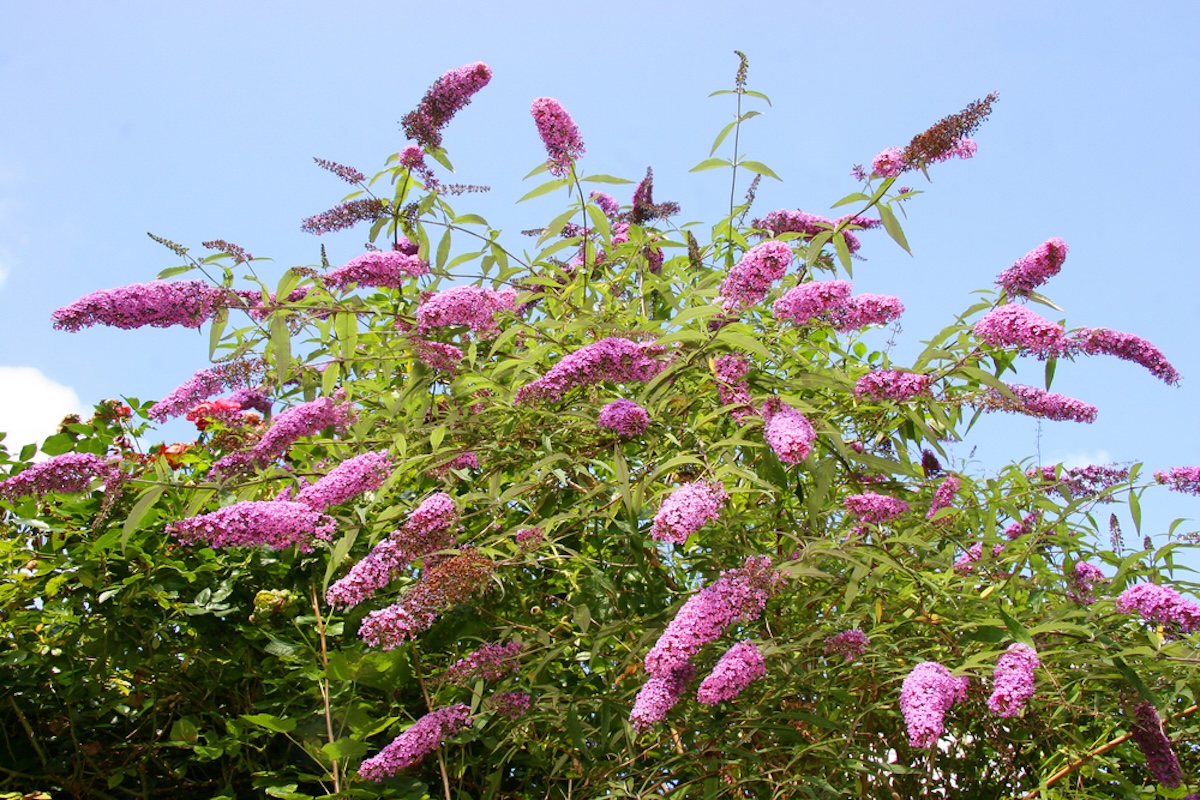
Although controversial for its non-native status and tendency to be invasive in some areas, butterfly bush is one of the most attractive shrubs you can plant for front yard charm. While traditional varieties reseed easily in some regions, it does not spread invasively throughout the country, and it’s a great choice for dry climates. Look for new varieties bred to be sterile if invasiveness is a concern. Buddleja davidii ‘Purple Haze’ is a sterile, low-growing cultivar, and B. davidii ‘Miss Violet’ grows to about 5 feet. Although not a food host for native butterflies, the attractive plant attracts butterflies, hummingbirds, and other pollinators.
Best For: Attractive pink to purple flowers on a shrub with natural-looking growth
USDA Hardiness Zones: 5 to 9
Size: 5 to 12 feet high; 8 to 10 feet wide (2 to 3 feet high and wide dwarf varieties)
Light: Full sun
16. Spirea (Spirea spp.)

Spirea is one of the easiest and most popular shrubs to grow in cool to temperate regions. This fast grower can hold its own in the landscape as a specimen plant, or complement groupings as a hedge or border. Bridal wreath spirea (Spirea prunifolia) produces tiny bouquets of sweet-smelling white flowers on loose, arching branches in the spring, while Japanese spirea (S. japonica) features purple flower clusters that last through summer. Various cultivars of both types grow to modest shrub height and a natural round habit, but are amenable to pruning as needed. They fare best in well-draining soil.
Best For: Masses of cascading flowers in spring or summer (depending on the cultivar)
USDA Hardiness Zones: 3 to 8, depending on cultivar
Size: 4 to 8 feet high and wide
Light: Partial shade to full sun
17. Viburnum (Viburnum spp.)

Viburnum is a fast-growing native shrub that produces large “balls” of fragrant white flowers. This large and woody shrub must be planted where it has room to grow, but it can be successful as a foundation plant, screen, hedge, or border. Plant it a minimum of 6 feet from a house to give it room to mature. Across the more than 150 species of viburnum shrubs, foliage ranges from glossy green to dull dark green, but the foliage can turn scarlet or purple in the fall. Different cultivars like more or less sun, and all do best in well-draining, moist soil.
Best For: Large, fragrant, showy blooms
USDA Hardiness Zones: 2 to 11
Size: 6 to 15 feet high; 6 to 12 feet wide
Light: Partial shade to full sun
18. Bluebeard (Caryopteris clandonensis)
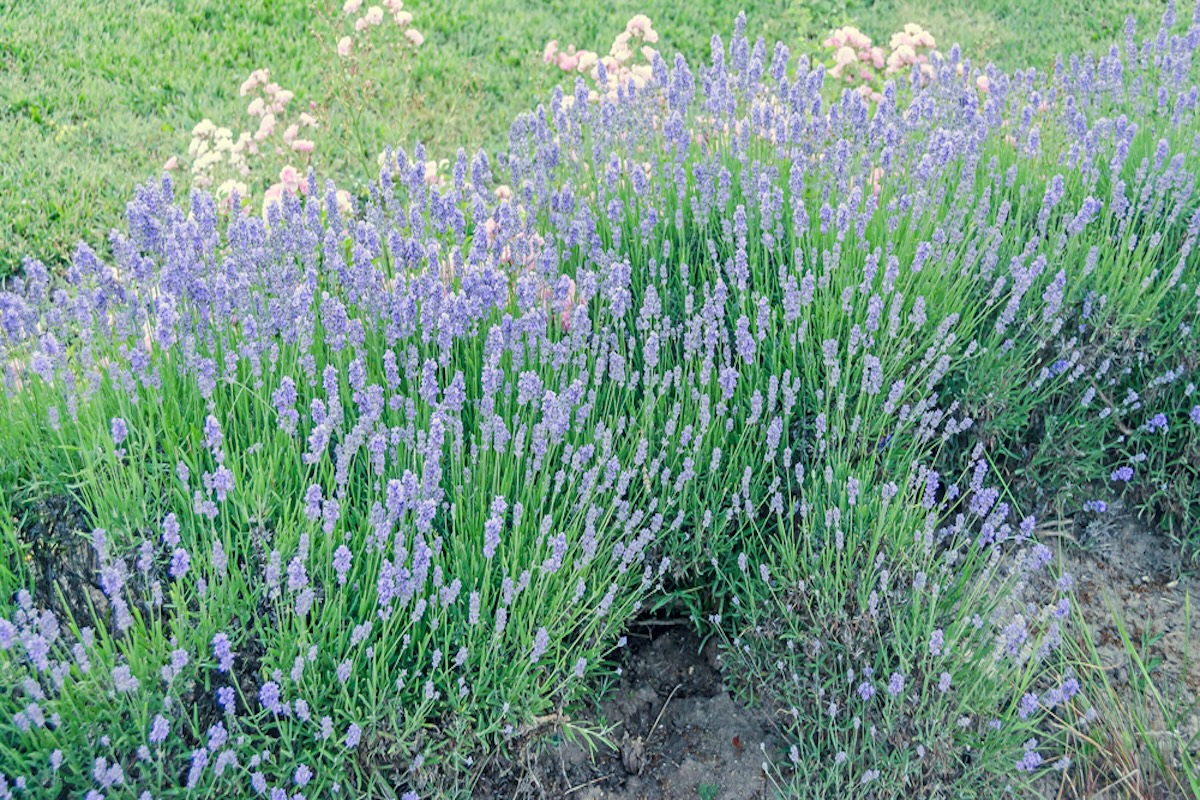
It’s hard to find true blue flowers on shrubs; Bluebeard is named for its small blue flower clusters that bloom in mid- to late summer through the fall. Because of its abundance of cloudlike flowers, it’s also known as Blue Mist spirea, although it’s not related to spirea. Its fragrant gray-green foliage fills in quickly each spring, even after a hard prune. The flowers are especially attractive to bees and need no deadheading to maintain 8 or more weeks of blooming. Bluebeard has no common disease problems and is a drought-tolerant shrub once established; plant a group together for a low-growing, low-water hedge. Give Caryopteris full sun and well-draining soil.
Best For: Abundant blue flowers in drought-prone areas
USDA Hardiness Zones: 6 to 9
Size: 2 to 3 feet high and wide
Light: Full sun
Tips for Planting Shrubs
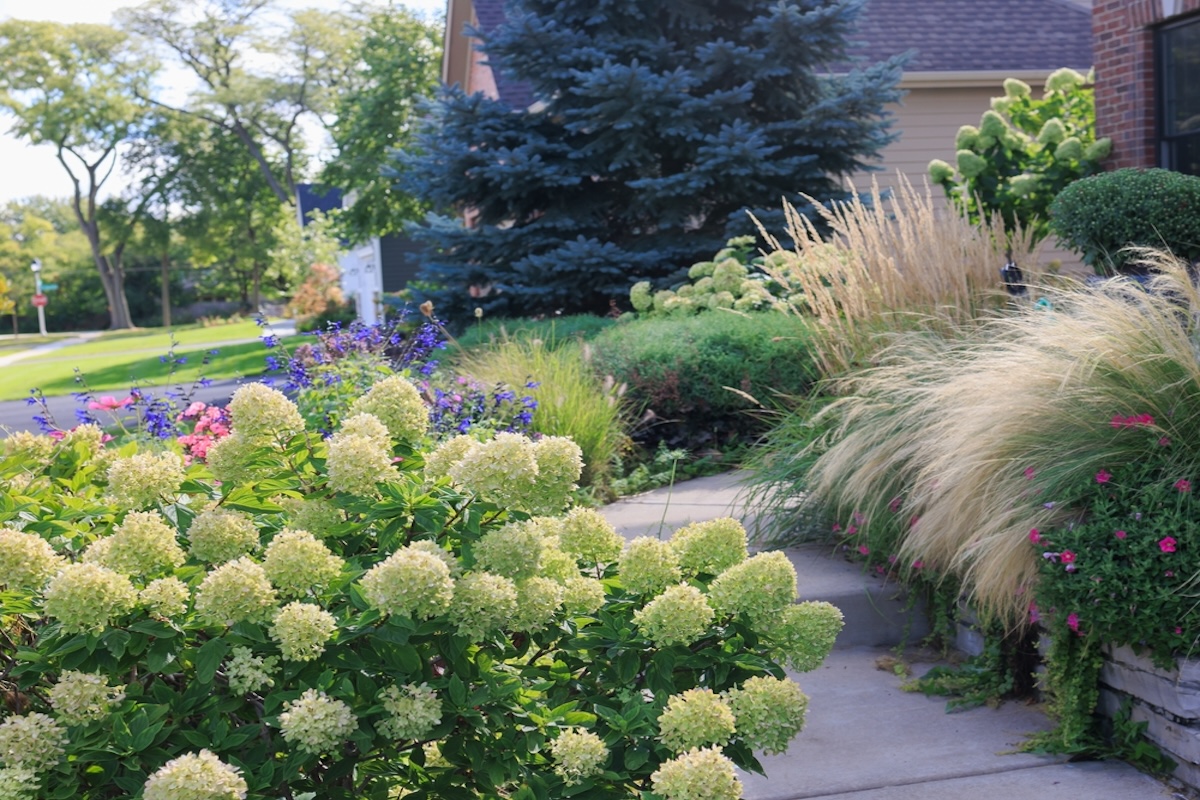
Successfully growing shrubs in the landscape starts with shrub selection. The information above can help you determine which shrubs will work best for your property’s conditions and needs. Also consider soil pH and drainage, and when to plant shrubs, along with these tips for placing your new plants in the ground.
- Unless plant information says otherwise, plant shrubs in spring or fall. In spring, wait until after the last frost; in fall, plant early enough for the plant to establish some roots before the first winter frost.
- Prepare the surrounding soil with amendments if recommended.
- Loosen soil beneath the root ball, but fill it in so that the new shrub sits no deeper in the ground than it did in the container.
- Always dig a hole at least twice as wide as the shrub’s current rootball or container.
- Rough up or tease a new shrub’s roots to free them from the compression or circling in their container.
- Place your new shrub so the crown is at the same level as it was in the pot, typically even with the surrounding soil, but according to plant directions.
- Water any new shrub deeply after planting, and water even drought-tolerant shrubs a little more than recommended in care instructions for their first year or so to help them establish roots.
- Monitor your new shrub to ensure it is not wilting; provide temporary shade if necessary to ease the shock of transplanting in high heat.
- When planting hedges, look for credible information on the spacing of plants. They need enough room between each other to grow, but not so much space that your hedge will have gaps.
FAQ
The lowest maintenance shrub for your front yard depends on your growing zone, but boxwood, forsythia, and spirea rank among the top common shrubs with the least maintenance. Still, if you plan to shape your boxwood into topiary or a hedge, you will need to work harder than if you let it grow to its natural shape.
Evergreen shrubs such as holly, juniper, boxwood, and yew tend to look good all year since they maintain their foliage. However, some plants, such as serviceberry and viburnum, offer seasonal interest, with foliage that changes color in autumn before falling off, although some viburnum varieties maintain their foliage. Euonymus offers the best of both worlds: Some produce fall color, and the evergreen varieties do not lose their leaves.
Low-growing perennials are your best bet for adding texture or color to plant groupings when the shrubs are not blooming. For example, low-growing coral bells (Heuchera) feature colorful bronze leaves to contrast with holly’s green foliage. With more natural landscapes, opt for ornamental grasses before hedges or near shrubs that drop their leaves to add some winter color from seedheads and movement in the wind. Good options are little bluestem grass (Schizachyrium scoparium) and feather reed grass (Calamagrostis).
For many parts of the country, juniper is a good foundation shrub, since it is evergreen, easy to care for, and comes in a variety of heights. You can plant low-growing juniper under windows or taller varieties at the corners of your house. Weigela and hydrangea are good companions for junipers in sunny areas. In drier mountain climates, potentilla offers excellent color as a juniper companion.
